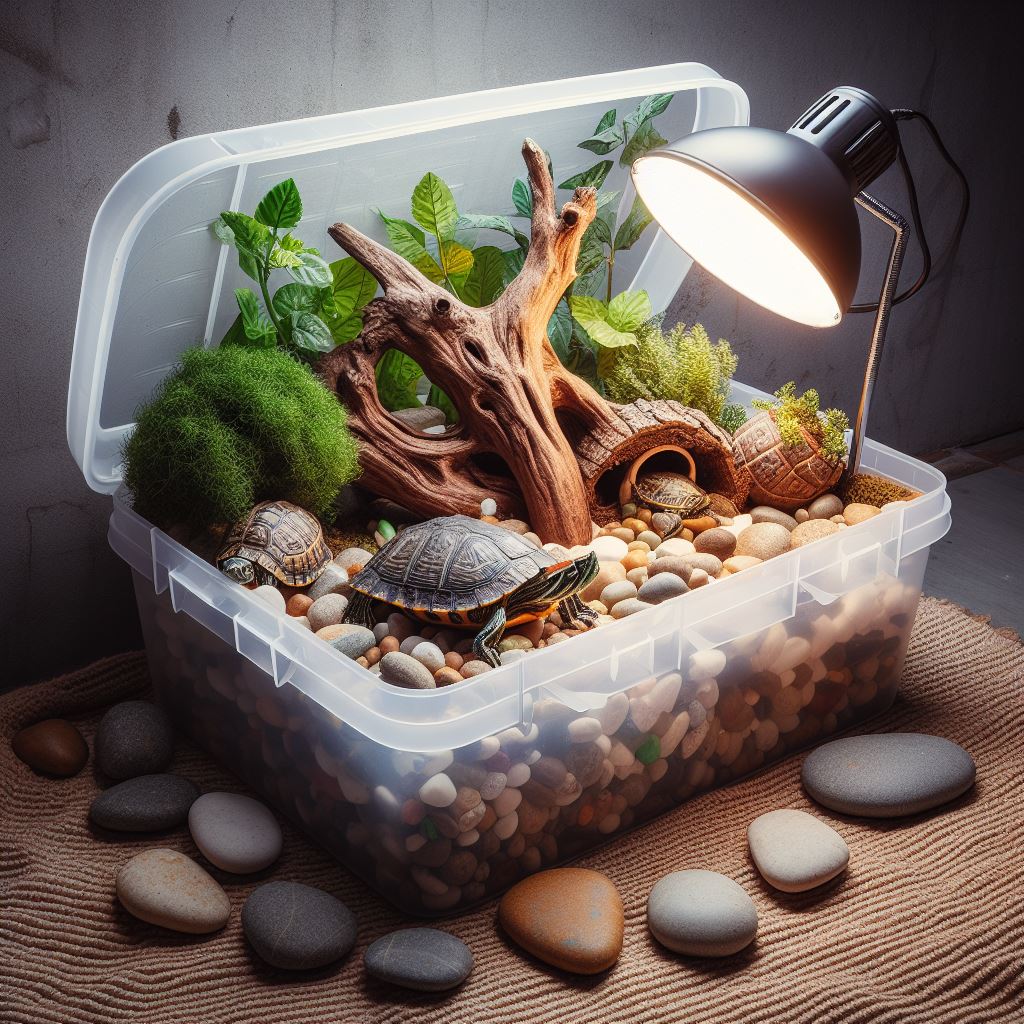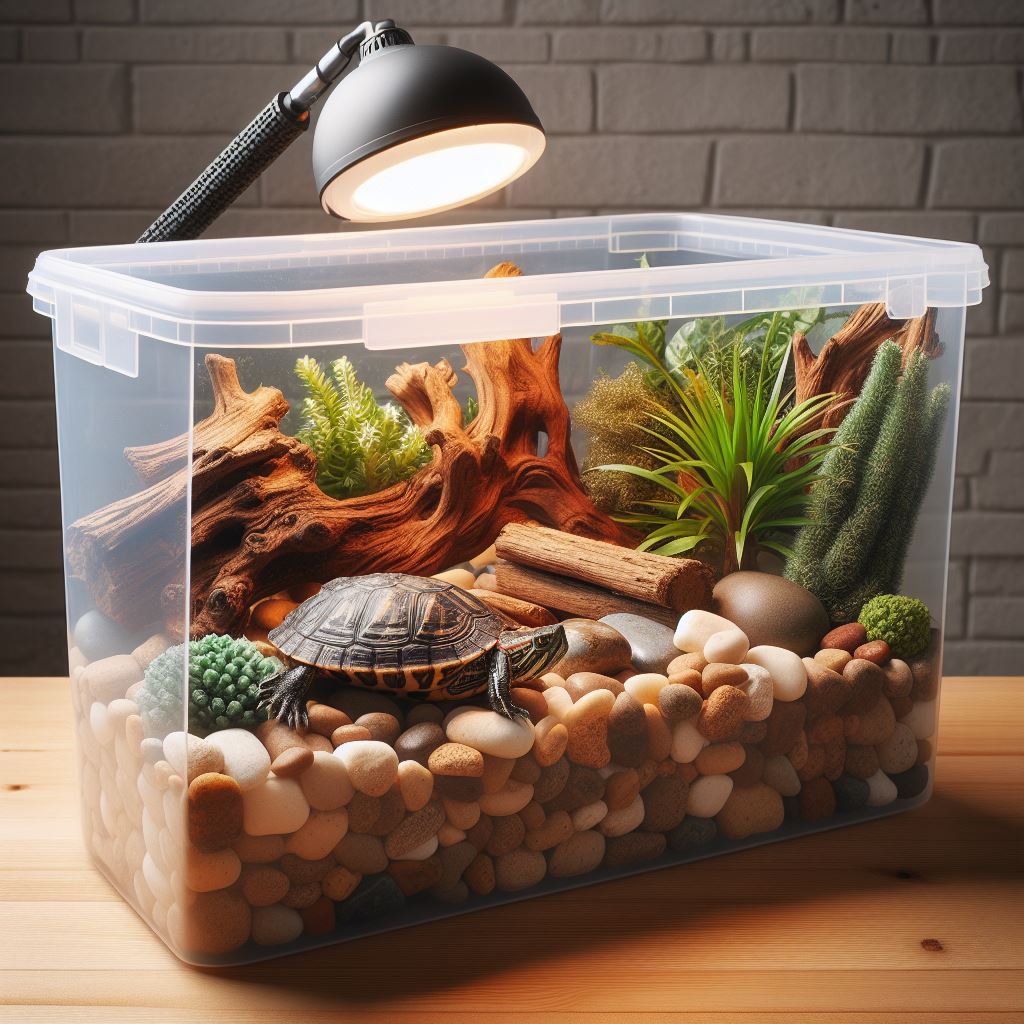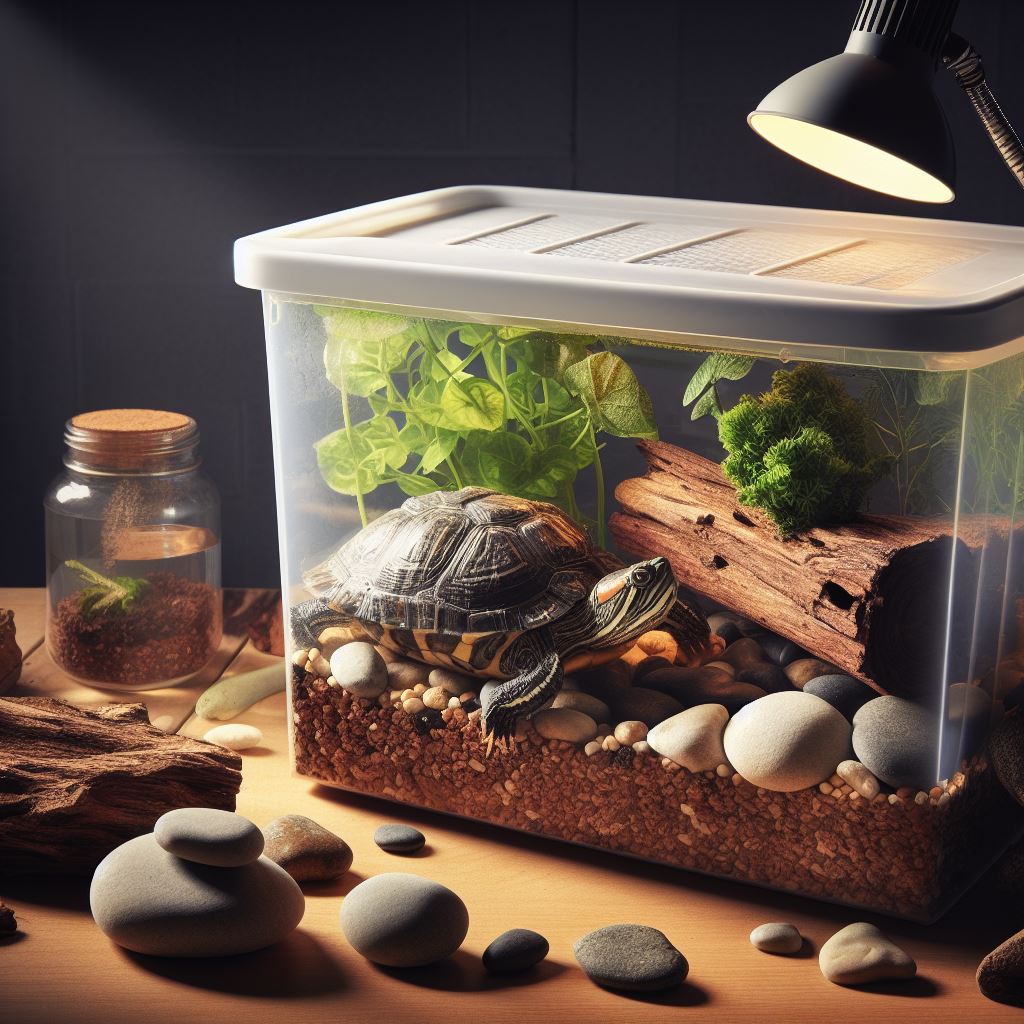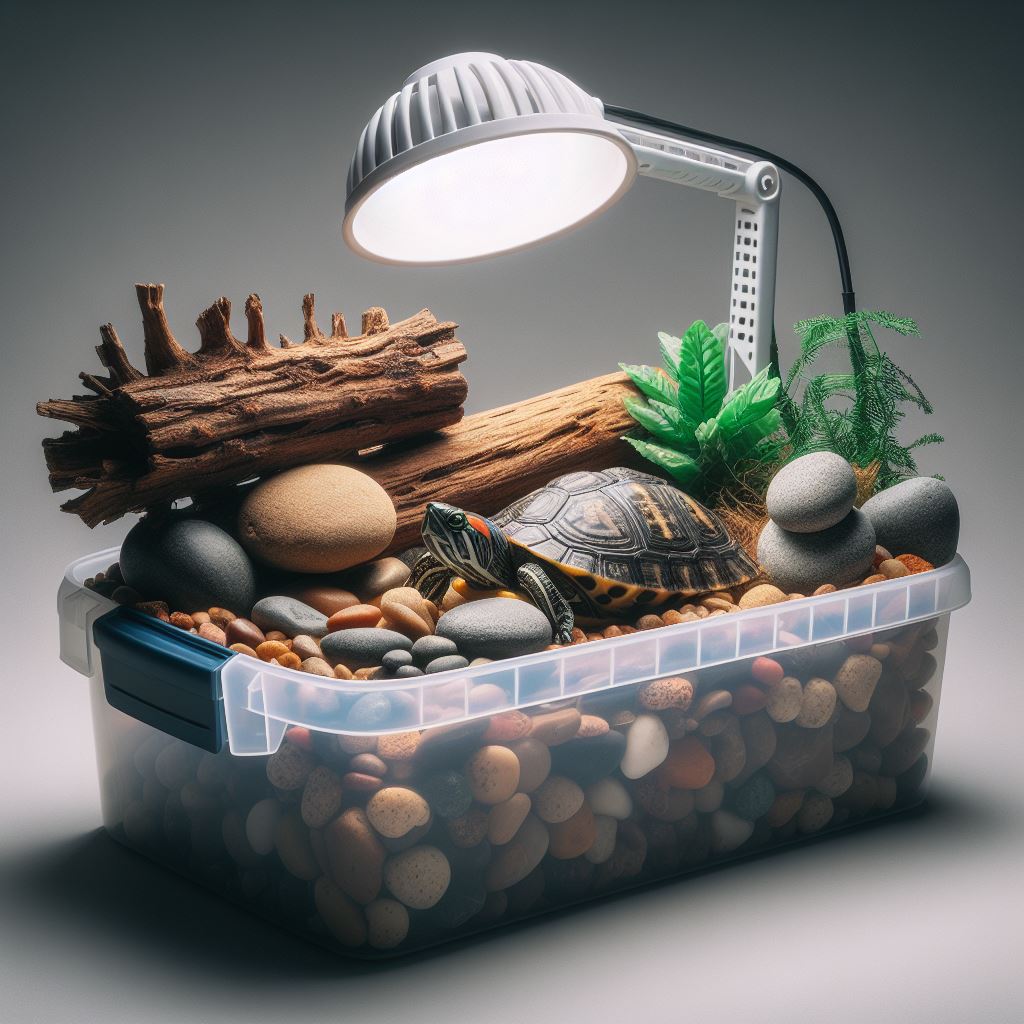Making a turtle habitat from household items is simple and cost-effective. In this guide, we will show you how to create a comfortable and safe space for your pet turtle using items commonly found in your home.
By following these steps, you can provide a suitable habitat for your turtle to thrive, including a tank or enclosure, substrate, lighting, heating, water source, and decorations. With a little creativity and resourcefulness, you can turn everyday objects into an ideal habitat for your turtle, ensuring its health and happiness.

Understanding The Needs Of A Turtle
Turtles are fascinating creatures that require careful consideration and attention when creating a habitat for them to thrive. By understanding their specific needs, you can ensure a comfortable and stimulating environment for your pet. Here are some key points to consider:
- Researching optimal turtle habitats:
- Different turtle species have varying habitat requirements, such as temperature, humidity, and water quality. Research the specific needs of your chosen turtle species to create an appropriate habitat.
- Consider the size of the habitat based on the turtle’s size and growth potential. Turtles need ample space to move around and explore.
- Provide a suitable basking area with a heat source, such as a heat lamp or heating pad, to allow the turtle to regulate its body temperature.
- Ensure access to clean, chlorine-free water for swimming and drinking purposes. A water filter and regular water changes are essential for maintaining water quality.
- Determining the appropriate turtle species for your household:
- Some turtle species are better suited to life in captivity than others. Consider factors such as their size, lifespan, and dietary requirements before choosing a turtle species.
- Evaluate the space available in your home, as larger turtle species may require more significant enclosures.
- Research the legal restrictions, if any, on keeping certain turtle species as pets. Some species may be protected or illegal to own in certain areas.
- Analyzing the significance of a well-designed turtle habitat:
- A well-designed habitat is crucial for the overall health and well-being of your turtle. It provides them with the proper environment to engage in their natural behaviors.
- A stimulating habitat can promote mental and physical exercise, preventing boredom and potential health issues.
- Creating a comfortable and safe habitat minimizes stress and ensures your turtle’s immune system remains strong.
- A well-maintained habitat reduces the risk of diseases and infections, promoting longevity for your pet turtle.
Remember, understanding the needs of your turtle and providing a suitable habitat is vital for their overall health and happiness. Take the time to research and plan accordingly, as it will contribute to a thriving turtle habitat in your home.
Preparing The Ideal Turtle Habitat
Turtles make fascinating pets, and creating a suitable habitat for them is essential for their overall well-being. By using household items, you can easily create a comfortable and safe environment for your little reptilian friend. Here are some key factors to consider when preparing the ideal turtle habitat:
Selecting A Suitable Container For Your Turtle Habitat
- Opt for a container that is spacious enough to accommodate your turtle comfortably. A general rule of thumb is to provide at least 10 gallons of water per inch of your turtle’s shell length.
- Consider using a plastic storage tub or a glass aquarium as a habitat container. These containers provide enough space for your turtle to swim and bask.
- Ensure that the container has a secure lid to prevent your turtle from escaping and to maintain a stable temperature and humidity level.
Choosing The Right Substrate For The Turtle’S Comfort
- Line the bottom of the turtle habitat with a suitable substrate. Gravel or small pebbles might look appealing, but they can cause digestive issues if accidentally ingested by your turtle.
- Opt for a substrate composed of river rocks, large marbles, or smooth aquarium gravel. These options are safer and easier to clean.
- Avoid using sand or dirt as substrates since they may be ingested by your turtle during feeding or water activities, leading to potential health problems.
Creating A Safe And Spacious Basking Area
- Turtles require a basking area where they can rest and dry out fully. Designate a spacious part of the habitat solely for this purpose.
- Use a flat and sturdy rock or platform to create the basking area. Ensure that it is large enough for your turtle to comfortably climb on and stretch out.
- Position a heat lamp or uvb light above the basking area to provide warmth and simulate natural sunlight. This will help regulate your turtle’s body temperature and promote proper growth and shell development.
- Monitor the temperature of the basking area regularly to ensure that it remains between 85-90°f (29-32°c) for most aquatic turtle species.
Remember, creating the ideal turtle habitat requires careful consideration of their natural needs. By selecting a suitable container, choosing the right substrate, and providing a safe and spacious basking area, you can ensure your turtle leads a healthy and happy life in their new home.
Now that you have prepared the ideal turtle habitat, it’s time to introduce your turtle to its new environment and start observing its playful behavior and daily routines. Keep reading our blog for more exciting tips and insights on turtle care!

Essential Components For A Turtle Habitat
Turtles are fascinating creatures that make for great pets. When creating a habitat for your pet turtle, there are a few essential components that you must include to ensure their well-being and overall health. Let’s dive into the key elements that are necessary for a turtle habitat:
Providing Adequate Lighting For The Turtle’S Well-Being
- Natural light exposure: Turtles, just like any other reptile, require exposure to natural light. Ensure that the turtle habitat is placed in an area where it can receive ample natural light throughout the day. This will not only provide them with essential vitamin d3 but also help regulate their internal body clock.
- Uvb lighting: In addition to natural light, it is crucial to provide uvb lighting in your turtle’s habitat. Uvb bulbs mimic the sun’s natural uvb rays, which are necessary for the synthesis of vitamin d3 in their bodies. This helps in the absorption of calcium, which is vital for their shell and overall bone health.
- Basking light: Turtles are ectothermic, meaning they rely on external sources to regulate their body temperature. A basking light is essential as it creates a warm spot within the habitat where turtles can raise their body temperature. It is important to monitor the temperature to prevent overheating.
Installing A Temperature Control System For Maintaining Optimal Conditions
- Thermometer: Maintaining the right temperature is crucial for your turtle’s well-being. Install a reliable thermometer in the habitat to monitor temperature levels accurately. Turtles generally require a basking area with a temperature ranging from 85 to 90 degrees fahrenheit (29-32 degrees celsius) and a cooler area around 75 to 80 degrees fahrenheit (24-27 degrees celsius).
- Heating lamps or mats: To create the optimal temperature gradient for your turtle, use heating lamps or heating mats in the basking area. These devices will help maintain the desired temperature required for digestion, metabolism, and overall activity levels of your pet turtle.
Incorporating A Filtration System For Water Quality Management
- Filter: Turtles spend a significant amount of time in the water, so it is essential to have a reliable filtration system in place. A good filter will help remove debris, excess food, and waste from the water. This ensures that the water remains clean and free from harmful bacteria, promoting a healthy environment for your pet turtle.
- Water heater: Turtles are ectothermic creatures, and their body temperature depends on the surrounding environment. To ensure that the water in their habitat remains at an optimal temperature, consider using a water heater. This will help maintain a consistent temperature, keeping your turtle comfortable and active.
Remember, providing the right lighting, temperature control, and water filtration are essential for creating a suitable habitat for your pet turtle. By incorporating these key components, you can ensure that your turtle thrives in a safe and comfortable environment.
Setting Up The Basking Area
Creating a suitable basking area is crucial for your turtle’s overall well-being and health. Turtles need a dry spot to rest, warm up, and soak in essential uvb rays. Here are the key points to consider when setting up the basking area for your turtle:
Selecting The Ideal Basking Platform For Your Turtle
- Choose a basking platform that is large enough for your turtle to comfortably climb onto and move around. A platform that matches the size of your turtle’s shell is best.
- Look for a platform that is sturdy and secure, ensuring it can support the weight of your turtle without tipping over.
- Opt for a basking platform with a non-slip surface or add a grip material to prevent your turtle from slipping and potentially getting injured.
- Natural materials such as rocks or logs make great basking platforms as they provide texture and mimic the turtle’s natural habitat.
Placing The Basking Area Strategically Within The Habitat
- Position the basking area near the heat source in your turtle’s enclosure. This will allow the basking spot to reach the desired temperature for your turtle’s thermoregulation.
- Place the basking area away from water sources to prevent splashing and keep the area dry. Turtles need a separate area to bask and swim.
- Ensure that the basking area is easily accessible for your turtle. Consider the height of the platform, making it easy for your turtle to climb up and down as needed.
- If you have multiple turtles, provide multiple basking areas to avoid aggression and crowding issues.
Ensuring The Temperature Of The Basking Area Is Suitable For The Turtle’S Needs
- Use a thermometer to monitor the temperature of the basking area. The ideal temperature for most turtles is around 85-90°f (29-32°c).
- Adjust the distance between the basking platform and the heat source to achieve the desired temperature. Move it closer to the heat source for more warmth or farther away for a cooler basking spot.
- Ensure that the basking area is warm enough for your turtle, but not too hot to avoid causing burns or overheating.
- If necessary, use heating lamps or ceramic heat emitters to maintain a consistent temperature in the basking area.
By following these guidelines, you can create a suitable and comfortable basking area for your turtle within its habitat. Remember to regularly monitor the temperature and make adjustments as needed to provide the best possible conditions for your turtle’s basking needs.
Establishing The Water Environment
Making a turtle habitat out of household items is not only a cost-effective solution, but it also provides an opportunity for creativity. One of the crucial elements in creating a turtle habitat is establishing the water environment. Turtles are semi-aquatic creatures and require a suitable water setup to thrive.
In this section, we will explore the key steps involved in achieving a healthy and engaging water environment for your turtle.
Determining The Appropriate Water Depth And Volume
- Ensure the water depth allows your turtle to fully submerge its entire body. As a general guideline, aim for a depth ranging from four to six times the shell length of your turtle.
- Consider the size and species of your turtle when determining the water volume. Most turtles require at least ten gallons of water per inch of their shell length. However, larger turtles may need a more spacious habitat.
Adding Aquarium-Safe Decorations For Aesthetic Appeal And Enrichment
- Incorporate diverse decorations such as rocks, logs, and plants. These elements not only enhance the visual appeal of the habitat but also provide platforms for basking and hiding spots for your turtle.
- Opt for aquarium-safe materials to ensure the health and safety of your turtle. Avoid using items with sharp edges, toxic paints, or substances that could contaminate the water.
Maintaining Water Quality Through Proper Filtration And Regular Cleaning
- Install a reliable filtration system to keep the water clean and free from harmful chemicals and waste buildup. A good filter will help remove debris, excess food, and ammonia from the water.
- Monitor the water temperature regularly, as turtles require a specific range to thrive. The ideal water temperature varies depending on the turtle species, so research your turtle’s specific needs and adjust the settings accordingly.
- Conduct regular water changes to maintain optimal water quality. Replace a portion of the water at least once a week, ensuring the replacement water is dechlorinated and at the appropriate temperature.
Now that you have established the water environment, your turtle will have a comfortable and enriching habitat to call home. Remember to regularly monitor and maintain the water conditions to ensure the well-being of your turtle.
Enhancing The Turtle Habitat With Household Items
Creating a turtle habitat that mimics their natural environment is essential for their well-being and happiness. While there are many commercial turtle habitats available, you can also utilize household items to enhance their habitat. By incorporating natural materials, providing hiding spots, and adding live or artificial plants, you can create a comfortable and stimulating habitat for your shelled friends.
Utilizing Natural Materials Such As Rocks And Driftwood For Aesthetic Value
- Rocks and driftwood not only add visual appeal to the turtle habitat but also provide a sense of naturalness for the turtles.
- Ensure that the rocks and driftwood are thoroughly cleaned and sanitized before adding them to the habitat to prevent any potential parasites or harmful bacteria.
- Position the rocks and driftwood strategically, creating platforms for basking or climbing, as turtles enjoy both activities.
- Avoid using sharp or jagged rocks that could potentially harm the turtles. Smooth, rounded rocks are safer and more comfortable for them to navigate.
Creating Hiding Spots With Household Objects Like Pvc Pipes And Terracotta Plant Pots
- Turtles seek shelter and privacy for their overall well-being. Pvc pipes and terracotta plant pots can be repurposed to create hiding spots within their habitat.
- Cut sections of pvc pipes of suitable diameter and create tunnels or caves by connecting them together. Ensure that the edges are smooth to prevent potential injuries.
- Terracotta plant pots, with their natural appearance and porous texture, make excellent hiding spots for turtles. Place them on their sides or slightly tilted to provide secure hiding places.
- You can bury some of the hiding spots partially in the substrate, giving the turtles an opportunity to dig their way in and make it feel even more natural.
Incorporating Live Or Artificial Plants To Simulate A Natural Habitat
- Live plants not only add a touch of beauty to the turtle habitat but also offer numerous benefits for the turtles, including providing them with shade, oxygenating the water, and enhancing the water quality by absorbing nitrates.
- Choose aquatic plants that are safe for turtles and can survive in the specific water conditions of their habitat. Some suitable options are water lettuce, duckweed, and java fern.
- If live plants are not feasible, artificial plants that closely resemble aquatic vegetation can be used instead. Make sure they are safe and non-toxic for turtles to prevent any accidental ingestion.
- Position the plants strategically to provide shade and create barriers or nooks for the turtles to explore, swim through, or simply rest on.
Enhancing the turtle habitat with household items not only saves you money but also gives you the flexibility to customize the environment according to your turtle’s needs and preferences. By carefully selecting natural materials, creating hiding spots, and incorporating live or artificial plants, you can create a stimulating and aesthetically pleasing habitat that your turtles will love to call home.
Maintaining And Caring For The Turtle Habitat
Creating a turtle habitat out of household items is an exciting diy project that can provide a safe and comfortable living space for your shelled friends. However, it’s essential to establish a regular cleaning and maintenance routine to ensure the health and well-being of your turtles.
Monitoring water temperature, lighting, and humidity levels is also crucial, as is providing a balanced diet and addressing any nutritional requirements.
Establishing A Regular Cleaning And Maintenance Routine
To keep your turtle habitat clean and hygienic, follow these steps:
- Regularly remove any uneaten food, feces, and debris from the habitat.
- Clean the tank or enclosure at least once a week. Empty the water, scrub the surfaces, and replace with fresh dechlorinated water.
- Use a reptile-safe disinfectant to sanitize the habitat during each cleaning session.
- Check the filters and other equipment regularly and clean or replace as needed.
- Monitor the water quality using a test kit and take necessary actions to maintain proper levels.
Monitoring Water Temperature, Lighting, And Humidity Levels
Maintaining the right environmental conditions is vital for the health of your turtles. Here’s what you need to do:
- Use a water heater and a reliable thermometer to maintain the water temperature within the recommended range for your turtle species.
- Install proper lighting fixtures to provide both uvb and uva light, as turtles require these for proper shell and bone development.
- Monitor the humidity levels in the habitat, ensuring it’s within the appropriate range for your turtle species.
- To increase humidity, use a reptile fogger or mist the habitat regularly.
- If humidity is too high, improve ventilation or reduce water surface area.

Providing A Balanced Diet And Addressing Any Nutritional Requirements
A nutritious diet is crucial for the health and vitality of your turtles. Follow these guidelines:
- Offer a variety of commercial turtle pellets as the foundation of their diet.
- Supplement their diet with fresh vegetables and fruits, such as leafy greens, carrots, and apples.
- Provide occasional sources of animal protein, such as earthworms or small fish, to meet their natural dietary needs.
- Consider adding calcium and vitamin d3 supplements to prevent deficiencies and promote healthy shell growth.
- Research the specific nutritional requirements of your turtle species to ensure optimal care.
By following these steps and guidelines, you can create and maintain a turtle habitat that promotes the well-being of your shelled companions. Remember that keeping a turtle requires commitment and responsibility, so continue educating yourself on their care needs and provide them with a nurturing environment for a happy and healthy life.
Frequently Asked Questions For How To Make A Turtle Habitat Out Of Household Items?
How Can I Make A Turtle Habitat Using Household Items?
You can create a turtle habitat using a plastic container, rocks, water, and a basking area made of wood or a floating platform. Make sure to include a uvb light source and a small water filter to keep the water clean.
Don’t forget to add plants and hiding spots to mimic a natural environment for your turtle.
What Kind Of Container Should I Use For A Turtle Habitat?
A plastic storage container with a lid makes an ideal habitat for your turtle. Choose a container large enough to accommodate your turtle’s size and provide enough swimming and basking areas. Make sure the container is easy to clean and has a secure lid to prevent escapes.
How Often Should I Clean The Turtle’S Habitat?
To maintain a healthy habitat, clean your turtle’s tank once a week. Remove any uneaten food, debris, and waste from the water using a net or siphon. Clean the tank with a mild detergent, rinse thoroughly, and refill with clean water.
Regular cleaning helps prevent diseases and keeps your turtle happy.
Conclusion
Creating a turtle habitat using household items is a fulfilling and sustainable way to provide a comfortable living space for your pet. By repurposing common items, you can design a habitat that meets your turtle’s needs while fostering their overall well-being.
Remember to prioritize safety by ensuring proper ventilation, temperature control, and cleanliness. Incorporate natural elements such as rocks, plants, and hiding spots to create a stimulating environment for your turtle. Additionally, regularly monitor and maintain the habitat to ensure the health and happiness of your pet.
With a little creativity and resourcefulness, you can transform everyday objects into a functional and visually appealing turtle habitat. Not only will your turtle thrive in its new home, but you will also contribute to a more sustainable lifestyle by reusing items that would otherwise go to waste.
Start building your turtle habitat today and enjoy the rewarding experience of providing a cozy sanctuary for your shelled friend.





Leave a Reply